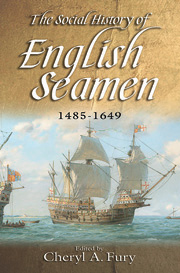Book contents
- Frontmatter
- Contents
- Illustrations
- Contributors
- List of Abbreviations
- Introduction
- 1 The English Maritime Community, 1500–1650
- 2 The Work of G.V. Scammell
- 3 The Men of the Mary Rose
- 4 Tudor Merchant Seafarers in the Early Guinea Trade
- 5 The Elizabethan Maritime Community
- 6 The Religious Shipboard Culture of Sixteenth and Seventeenth-Century English Sailors
- 7 Health and Health Care at Sea
- 8 The Relief of English Disabled Ex-Sailors, c. 1590–1680
- 9 Seamen's Wives and Widows
- 10 Jacobean Piracy: English Maritime Depredation in Transition, 1603–1625
- Conclusion
- Bibliography
- Index
Introduction
Published online by Cambridge University Press: 05 September 2013
- Frontmatter
- Contents
- Illustrations
- Contributors
- List of Abbreviations
- Introduction
- 1 The English Maritime Community, 1500–1650
- 2 The Work of G.V. Scammell
- 3 The Men of the Mary Rose
- 4 Tudor Merchant Seafarers in the Early Guinea Trade
- 5 The Elizabethan Maritime Community
- 6 The Religious Shipboard Culture of Sixteenth and Seventeenth-Century English Sailors
- 7 Health and Health Care at Sea
- 8 The Relief of English Disabled Ex-Sailors, c. 1590–1680
- 9 Seamen's Wives and Widows
- 10 Jacobean Piracy: English Maritime Depredation in Transition, 1603–1625
- Conclusion
- Bibliography
- Index
Summary
The Tudor-Stuart era was formative and turbulent for its seamen. The stresses of cycles of war and peace and the push for European ‘out thrust’ had an impact of all forms of maritime employment.
English, and later, British, maritime expansion has been analysed by gener-ations of historians but until relatively recently, the focus has been placed on events and participants ‘at the top’. The adventures of the famous and infamous captains like Drake and Frobisher are only a small part of the story: we must understand the experiences of all the men on those ships if we hope to grasp the ‘big picture’.
Historians such as K.R. Andrews and G.V. Scammell did much to establish and advance the field. In his seminal article, ‘The Elizabethan Seaman’ (1982), Andrews gave credit to Scammell's pioneering work, ‘Manning the English Merchant Service in the Sixteenth Century’ (1970) for laying the groundwork for this field of study. Andrews claimed the subject ‘cried out’ for a large-scale study. Over the past two decades a number of scholars have taken up the torch and the research has not been limited to the Elizabethan period. The endeavour has been assisted by the popularity of ‘history from below’.
Once there was a will to rescue these men from the dim past, scholars had to be creative in findings ways to do it. Official records of the time make little mention of the men who crewed the vessels which opened the global market-place to England and allowed for fledgling colonies – the fragile beginnings of Britain's great empire.
- Type
- Chapter
- Information
- The Social History of English Seamen, 1485-1649 , pp. 1 - 4Publisher: Boydell & BrewerPrint publication year: 2012

